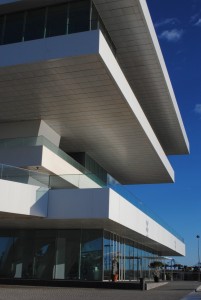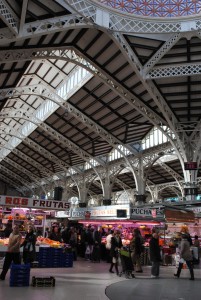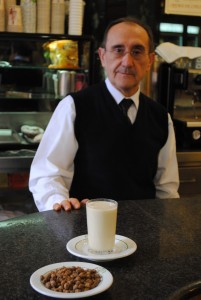 My journey from freezing Madrid, where the weather forecast kept predicting snow, to warm, sunny Valencia took exactly two hours, but it was like going to another country altogether. The skies in Valencia resolutely remained fiercely blue, orange trees lined every street; one end of the city was bound by a beach, along which ran a line of paella restaurants. The old part of the city was crammed with historic squares, churches and clock towers, while the new part was graced with the cutting edge City of Arts and Sciences designed by architect Santiago Calatrava. Add to it the largest historic covered market in the country, the home of not only paella but also the little known tigernut (yes! You read that right!) and also a super potent drink called Agua de Valencia, so famous that it is now branded and sold in bottles to eager tourists. And no, this is not all that Valencia has to offer: it is but a foretaste.
My journey from freezing Madrid, where the weather forecast kept predicting snow, to warm, sunny Valencia took exactly two hours, but it was like going to another country altogether. The skies in Valencia resolutely remained fiercely blue, orange trees lined every street; one end of the city was bound by a beach, along which ran a line of paella restaurants. The old part of the city was crammed with historic squares, churches and clock towers, while the new part was graced with the cutting edge City of Arts and Sciences designed by architect Santiago Calatrava. Add to it the largest historic covered market in the country, the home of not only paella but also the little known tigernut (yes! You read that right!) and also a super potent drink called Agua de Valencia, so famous that it is now branded and sold in bottles to eager tourists. And no, this is not all that Valencia has to offer: it is but a foretaste.
I was propping up the bar at Casa Montana. Young Alejandro Garcia Llinares was telling me how he and his wife bought an ancient wine cellar in newly fashionable El Cabanyal district and turned it into a smart bar where the accent is on the tapas: golden fried potatoes with garlic aioli and fava beans napped in a sauce so addictive I wonder if it has some illegal substance in it. Washing it down is a glass or three of Vermouth taken from the enormous casks that line the little bodega. Once you have spent time in Spain, you will figure out how to ration your intake.
 Grazing is the name of the game, and the more time you take to do it, and the more places you visit, the better you can be said to have mastered the game. So after exploring the marina with a desi connection, I was ready for paella (The desi connection, for those who care, is because Vijay Mallya found it difficult to dock his outsize yacht in the expansive marina. Authorities are now thinking of widening it before Shri Mallya comes calling again). Paella is a beautiful dish. It contains rice (of the variety known as bomba), and two or more of the following: garlic, garafon beans, broad beans, rabbit, chicken, seafood and saffron. It was traditionally made over a wood fire, but modern living being what it is, that is a thing of the past. The row of paella restaurants that overlook the beach all specialize in seafood paella. La Marcelina is usually acknowledged to be the most popular.
Grazing is the name of the game, and the more time you take to do it, and the more places you visit, the better you can be said to have mastered the game. So after exploring the marina with a desi connection, I was ready for paella (The desi connection, for those who care, is because Vijay Mallya found it difficult to dock his outsize yacht in the expansive marina. Authorities are now thinking of widening it before Shri Mallya comes calling again). Paella is a beautiful dish. It contains rice (of the variety known as bomba), and two or more of the following: garlic, garafon beans, broad beans, rabbit, chicken, seafood and saffron. It was traditionally made over a wood fire, but modern living being what it is, that is a thing of the past. The row of paella restaurants that overlook the beach all specialize in seafood paella. La Marcelina is usually acknowledged to be the most popular.
What is the main difference between biryani and paella is that a restaurant specializing in the former would have ready prepared all its biryani before the restaurant opened and kept it warm. The idea of cooking each order of biryani a la minute is laughable. In Valencia, each and every restaurant, no matter how tiny, cooks their paella to order. I guess it helps that the rice needs neither soaking nor washing and the paella pans are wide and shallow so that all liquid evaporates rapidly. Unlike biryani, where every restaurant or household would have a single recipe, paella really does come in several choices of meats. It is said that the original combination was rabbit and chicken with two types of beans, but lobster, shrimp, mussels, fish and any permutation and combination thereof is completely kosher. It doesn’t even have to be the trademark golden colour: my host, Miguel Angel Perez, Valencian to the core, ordered squid ink paella, so his rice was black.
 That first day was relaxed, and so Miguel Perez and I drove to the City of Arts and Sciences to walk about in the courtyards of the buildings and admire the curvilinear silhouettes of the science museum and the aquarium, set amidst open gardens where the sporty and fitness oriented portion of the population jogged and cycled their way through what were the lungs of the city. Speaking for myself, Calatrava’s vision was so extraordinary that it was like being in a museum. The very next day, amidst buildings that ranged from the 13th to 18th centuries, I felt that I was in an organically developing city that was being used by its inhabitants: the Arts and Sciences spectacle on the other hand, was a self-conscious spectacle, magnificent nevertheless.
That first day was relaxed, and so Miguel Perez and I drove to the City of Arts and Sciences to walk about in the courtyards of the buildings and admire the curvilinear silhouettes of the science museum and the aquarium, set amidst open gardens where the sporty and fitness oriented portion of the population jogged and cycled their way through what were the lungs of the city. Speaking for myself, Calatrava’s vision was so extraordinary that it was like being in a museum. The very next day, amidst buildings that ranged from the 13th to 18th centuries, I felt that I was in an organically developing city that was being used by its inhabitants: the Arts and Sciences spectacle on the other hand, was a self-conscious spectacle, magnificent nevertheless.
The next day was a whirlwind of visiting the iconic Central Market, built entirely of metal, like the Eiffel Tower and eating and drinking my way through a mountain of food and drink. The narrow streets of the old part of the city wound through lanes with a fair proportion of restaurants, bars and cafes. One of the cafes had another desi connection: Café De Las Horas right on Conde de Almodovar. Unabashedly over the top, quirky, colourful and artistic, the pedestrian only walkway is in the heart of the old town, a stone’s throw from the plaza with the Cathedral and the Basilica of the Virgin de los Desamparados, two partners own the Café (it’s actually a bar), one Indian. When I expressed my admiration of the interiors of his  bar, Marc Insanally went the extra mile to show me the photographs of ‘before’ and ‘after’ he and his partner did up the shed and made it drop dead glamorous with the kind of back-breaking work that no desi entrepreneur would ever dream of doing. It’s where I sampled my first Agua de Valencia – a blow-away-the-top-of-your-head cocktail made from vodka, gin, champagne or cava and fresh orange juice. You would think that any drink at all made and/or drunk in Valencia just had to have orange juice or pulp in it, going by the number of orange trees on every street. But you would not have taken into account the smooth, refreshing horchata. Made of tiger nuts – don’t be fooled by the name: their appearance is like shrivelled peanuts – horchata is a filling drink that is touted as a lactose-free alternative to milk. Apparently, you go for an evening walk and visit an horchateria for an ice-cold drink.
bar, Marc Insanally went the extra mile to show me the photographs of ‘before’ and ‘after’ he and his partner did up the shed and made it drop dead glamorous with the kind of back-breaking work that no desi entrepreneur would ever dream of doing. It’s where I sampled my first Agua de Valencia – a blow-away-the-top-of-your-head cocktail made from vodka, gin, champagne or cava and fresh orange juice. You would think that any drink at all made and/or drunk in Valencia just had to have orange juice or pulp in it, going by the number of orange trees on every street. But you would not have taken into account the smooth, refreshing horchata. Made of tiger nuts – don’t be fooled by the name: their appearance is like shrivelled peanuts – horchata is a filling drink that is touted as a lactose-free alternative to milk. Apparently, you go for an evening walk and visit an horchateria for an ice-cold drink.
There’s too much to tell you about Valencia: I plan to visit that city again during the unique Fallas celebrations, so there’ll be more stories yet.

